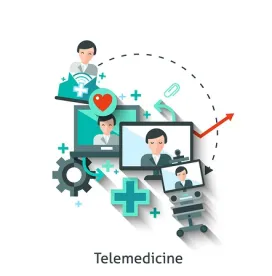Updates to OIG FY 2017 Work Plan
The United States Department of Health and Human Services (“HHS”) Office of the Inspector General (“OIG”) recently updated its FY 2017 Work Plan. Traditionally, OIG’s annual Work Plan has given health care providers a preview of OIG’s enforcement priorities. With the OIG now making updates to its Work Plan on a monthly basis, providers stand to gain even more insight into how the focus of OIG is constantly shifting in order to assist in the identification of significant compliance risk areas.
 In this most recent set of updates to the FY 2017 Work Plan, OIG announced that it will conduct a review of Medicare claims paid for telehealth services in FY 2017. Specifically, OIG is interested in reviewing claims for telehealth services provided at “distant sites” (i.e., the location of the provider of the telehealth service) that do not correspond with claims from an “originating site” (i.e., the location of the patient). By undertaking this review, presumably OIG seeks to verify that providers of telehealth services are: (1) appropriately rendering these services to Medicare beneficiaries based on current reimbursement rules under Medicare for provision of telehealth services (i.e., the beneficiary is at a valid originating site when receiving the telehealth service, which under current Medicare rules does not include a beneficiary’s home), and (2) not submitting fraudulent claims for telehealth services (i.e., services delivered outside of Medicare’s coverage and reimbursement scope). OIG’s review of these claims may demonstrate the need to update Medicare’s outdated coverage and reimbursement provisions for telehealth services.
In this most recent set of updates to the FY 2017 Work Plan, OIG announced that it will conduct a review of Medicare claims paid for telehealth services in FY 2017. Specifically, OIG is interested in reviewing claims for telehealth services provided at “distant sites” (i.e., the location of the provider of the telehealth service) that do not correspond with claims from an “originating site” (i.e., the location of the patient). By undertaking this review, presumably OIG seeks to verify that providers of telehealth services are: (1) appropriately rendering these services to Medicare beneficiaries based on current reimbursement rules under Medicare for provision of telehealth services (i.e., the beneficiary is at a valid originating site when receiving the telehealth service, which under current Medicare rules does not include a beneficiary’s home), and (2) not submitting fraudulent claims for telehealth services (i.e., services delivered outside of Medicare’s coverage and reimbursement scope). OIG’s review of these claims may demonstrate the need to update Medicare’s outdated coverage and reimbursement provisions for telehealth services.
Medicare’s Current Coverage of and Reimbursement for Telehealth Services
Compared to ever-expanding coverage of and reimbursement for telehealth services in individual states, as well as the private insurance market, Medicare Part B beneficiaries currently have limited access to telehealth services due to the following restrictions:
-
Medicare beneficiaries only have access to telehealth services transmitted using an “interactive 2-way telecommunications system (with real-time audio and video).” This definition excludes three frequently used modalities used by providers to deliver telehealth services: (a) store-and-forward technology (with the limited exceptions of CMS demonstration projects ongoing in Alaska and Hawaii), (b) remote patient monitoring (“RPM”) services, and (c) mobile health / wearable technology.
-
Medicare confines telehealth coverage to “rural health professional shortage area[s].” This geographic restriction is federally defined.
-
Medicare beneficiaries only may receive telehealth services while physically situated at one of eight “originating site[s],” none of which include the patient’s home—those living in geographically-restricted areas are still obligated to access a medical originating site in order to activate Medicare coverage.
-
Only eight types of practitioners may deliver the telehealth services to Medicare beneficiaries, and must do so from a qualified “distant site.”
-
The Centers for Medicare & Medicaid Services (“CMS”) publishes a limited number of HCPCS and CPT codes for telehealth services, and while this universe of codes has gradually increased over time, most of these codes are geared towards reimbursement for behavioral health services delivered through telehealth.
Current Legislative Efforts in Congress
In recent years, federal lawmakers have been working to lessen the constraints on Medicare Part B coverage of and reimbursement for telehealth services.
In August 2016, HHS published a Report to Congress on “E-Health and Telemedicine.” In this report, HHS expressed its support for telehealth expansion and its importance in the health care industry: “[T]elehealth holds promise as a means of increasing access to care and improving health outcomes.” Congress has seemed to take note. In the 2017–2018 legislative session, four key bills have been introduced that, if passed, would improve coverage of and reimbursement for telehealth services under Medicare:
-
The CHRONIC Care Act of 2017 (S. 870) would make four key changes to Medicare: (1) provide coverage and reimbursement for RPM delivery of home kidney dialysis assessments; (2) provide nationwide coverage and reimbursement for “telestroke” consultations (not just those that occur in rural hospitals or other originating sites); (3) eliminate the geographic restriction of an originating site for Accountable Care Organization (“ACO”) beneficiaries, thus allowing patients to receive home telehealth services; and (4) allow Medicare Advantage plans to offer telehealth benefits in annual bid amounts, instead of using rebate dollars to pay for telehealth as a “supplemental service.” The CHRONIC Care Act recently received a favorable, budget neutral Congressional Budget Office (“CBO”) score—alleviating a traditionally difficult roadblock for telehealth legislation.
-
The Medicare Telehealth Parity Act of 2017 (H.R. 2550) would provide an incremental expansion of coverage for telehealth services under Medicare by expanding the number of acceptable geographic locations for telehealth coverage under three “phases.”
-
The CONNECT for Health Act of 2017 (H.R. 2556) includes provisions that would expand coverage and reimbursement of telehealth services for (1) ACO enrollees, (2) individuals receiving kidney dialysis therapy, (3) stroke patients, and (4) RPM services for beneficiaries needing chronic care and would lift restrictions on telehealth for mental health services.
-
The HEART Act (H.R. 2291) aims to increase Medicare coverage of telehealth services, including coverage and payment for store-and-forward services delivered to “any telehealth services that are furnished from a distant site, or to an originating site, that is a critical access hospital . . ., a rural health clinic . . ., or a sole community hospital” and for home-based monitoring of congestive heart failure and chronic obstructive pulmonary disease. These three bills have not yet been scored by the CBO.
While it remains to be seen whether any of these bills (or any others) will become law, the level of legislative activity still is promising—and particularly so in conjunction with HHS’s support for telehealth—that expansion of telehealth coverage and reimbursement under Medicare can make greater strides toward improving access to these services for Medicare beneficiaries.
Added to this, OIG’s recent updates to the FY 2017 Work Plan to include a review of telehealth reimbursement claims under Medicare may further accelerate this process if OIG identifies any pertinent potential risk areas related to provision of telehealth services.
This post was written with assistance from Matthew Sprankle.




 />i
/>i
